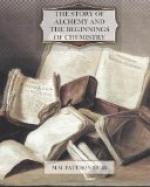[Illustration: FIG. XVI.]
The apparatus used by Priestley, in his experiments on different kinds of air, is represented in Fig. XVI., which is reduced from an illustration in Priestley’s book on Airs.
Priestley had made a discovery which was destined to change Alchemy into Chemistry. But he did not know what his discovery meant. It was reserved for the greatest of all chemists, Antoine Lavoisier, to use the fact stumbled on by Priestley.
After some months Priestley began to think it possible that the new “air” he had obtained from calcined mercury might be fit for respiration. To his surprise he found that a mouse lived in this air much longer than in common air; the new air was evidently better, or purer, than ordinary air. Priestley measured what he called the “goodness” of the new air, by a process of his own devising, and concluded that it was “between four and five times as good as common air.”
Priestley was a thorough-going phlogistean. He seems to have been able to describe the results of his experiments only in the language of the phlogistic theory; just as the results of most of the experiments made to-day on the changes of compounds of the element carbon cannot be described by chemists except by making use of the conceptions and the language of the atomic and molecular theory.[6]
[6] I have given numerous illustrations
of the truth of this
statement in the book, in this series,
entitled The Story of
the Wanderings of Atoms.
The upholder of the phlogistic theory could not think of burning as possible unless there was a suitable receptacle for the phlogiston of the burning substance: when burning occurred in the air, the part played by the air, according to the phlogistic chemist, was to receive the expelled phlogiston; in this sense the air acted as the pabulum, or nourishment, of the burning substance. Inasmuch as substances burned more vigorously and brilliantly in the new air than in common air, Priestley argued that the new air was more ready, more eager, than ordinary air, to receive phlogiston; and, therefore, that the new air contained less phlogiston than ordinary air, or, perhaps, no phlogiston. Arguing thus, Priestley, of course, named the new aeriform substance dephlogisticated air, and thought of it as ordinary air deprived of some, or it might be all, of its phlogiston.
The breathing of animals and the burning of substances were supposed to load the atmosphere with phlogiston. Priestley spoke of the atmosphere as being constantly “vitiated,” “rendered noxious,” “depraved,” or “corrupted” by processes of respiration and combustion; he called those processes whereby the atmosphere is restored to its original condition (or “depurated,” as he said), “dephlogisticating processes.” As he had obtained his dephlogisticated air by heating the calx of mercury, that is the powder produced by calcining mercury in the air, Priestley




